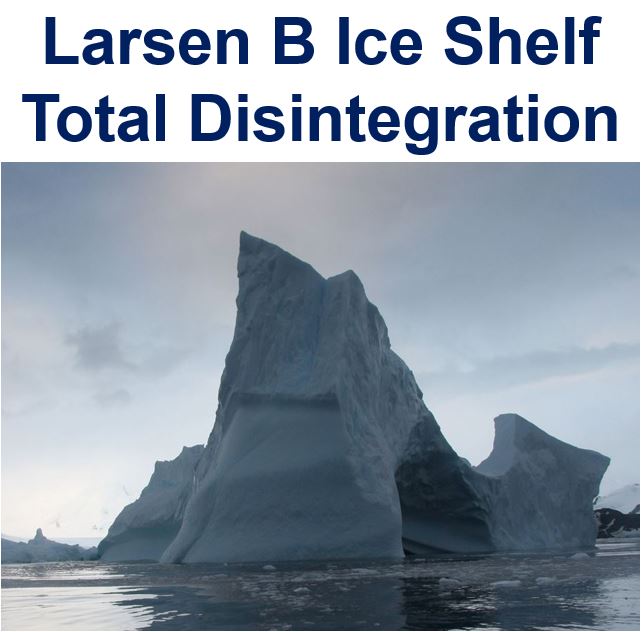A massive Antarctic ice shelf – Larsen B – is rapidly weakening and will probably disintegrate completely by 2020, scientists from NASA’s Jet Propulsion Laboratory (JPL) in Pasadena, California, warned on Thursday.
The last remaining section of Antarctica’s Larsen B Ice Shelf, part of which collapsed in 2002, is flowing more rapidly and is becoming progressively fragmented and developing huge cracks, the researchers discovered.
Two of the ice shelf’s tributary glaciers are also flowing much faster and thinning rapidly, they added.

When the ice shelf disintegrates completely, glaciers will flow into the sea more rapidly. (Image: NASA)
Dr. Ala Khazendar, a scientist in JPL’s Radar Science group, said:
“These are warning signs that the remnant is disintegrating. Although it’s fascinating scientifically to have a front-row seat to watch the ice shelf becoming unstable and breaking up, it’s bad news for our planet.”
“This ice shelf has existed for at least 10,000 years, and soon it will be gone.”
Ice shelves are glacier gatekeepers
Ice shelves are like gatekeepers, they stop glaciers from flowing from Antarctica into the sea. If the ice shelves are not there, glacial ice enters the ocean much more rapidly, which in turn speeds up the rate at which sea levels rise.
The scientists say their latest study was the first to look comprehensively at the health of the Larsen B remnant and the glaciers that flow into it. They published their findings in the academic journal Earth and Planetary Science Letters (citation below).
Dr. Khazendar and colleagues gathered and analyzed data on surface elevations and bedrock depths from instrumented airplanes which took part in NASA’s Operation IceBridge, an airborne survey campaign that provides unprecedented information on Antarctica’s glaciers, ice sheets and ice shelves.
Data on flow speeds were obtained from satellite observations (synthetic aperture radars).
The scientists pointed out that their estimate of the remaining section of Antarctica’s Larsen B Ice Shelf’s life span was based on the likely scenario that a massive, widening rift that had formed close to the ice shelf’s ground line would eventually crack right across.
Dr. Khazendar says the free-floating remnant will break up into hundreds of icebergs that will drift away, leaving the glaciers to move to the sea, unhindered, and thus shifting at an accelerating pace.
Larsen B remnant and two tributaries in trouble
The Larsen B remnant covers an area of 1,600 square kilometres (625 square miles), and is about 500 metres (1,640 feet) thick at its thickest point. It has three major tributary glacies, which are fed by their own tributaries further inland.
Dr. Khazendar said:
“What is really surprising about Larsen B is how quickly the changes are taking place. Change has been relentless.”
Larsen B’s main tributary glaciers are called Leppard, Starbuck and Flask – the latter two named after Moby Dick characters.
Following the 2002 partial collapse, the glaciers’ flow speeds and thicknesses changed only marginally, so scientists thought they remained stable.
However, according to the study’s findings, the Leppard and Flask glaciers have thinned by 20-22 metres (65-72 feet) and accelerated significantly in in the intervening years.
By 2012, the fastest-moving part of Flask Glacier had reached a flow speed of 700 metres (2,300 feet) per year – an acceleration of 36% – like a car speeding up from 55 mpg to 75 mph.
Flask’s acceleration, while the remnant has been weakening, could be just a prelude to what will occur when the remnant disintegrates completely.
After Larsen B’s partial collapse in 2002, the glaciers behind the collapsed part of the shelf sped up by a factor of eight – like a car moving from 55 mph to 440 mph.
Starbuck, the smallest of the three glaciers, has not changed much. Starbuck’s channel is narrow compared to those of the other two glaciers. It is also strongly anchored to the bedrock, which, according to the scientists, explains its comparative stability.
Co-author, Professor Eric Rignot, principal scientist for the JPL’s Radar Science and Engineering Section, said:
“This study of the Antarctic Peninsula glaciers provides insights about how ice shelves farther south, which hold much more land ice, will react to a warming climate.”
The study also included researchers from the University Centre in Svalbard, Norway, and the University of California, Irvine.
10ft sea level rise by 2100?
According to Princeton scientists, Antarctica’s ice is melting faster each year. A research team, after carrying out simulations of events dating back millions of years, have concluded that sea levels could go up by almost ten feet (3 metres) by the end of this century, unless drastic action to reduce emissions is taken soon.
Over the past decade, Antarctica’s massive ice sheet has lost twice as much ice in the west as its eastern portion managed to build up.
Citation: “The evolving instability of the remnant Larsen B Ice Shelf and its tributary glaciers,” Ala Khazendar, Christopher P. Borstad, Bernd Scheuchl, Eric Rignot and Helene Seroussi. Earth and Planetary Science Letters (June 2015). DOI: 10.1016/j.epsl.2015.03.014.
Video – Antarctica’s Larsen B Ice Shelf
